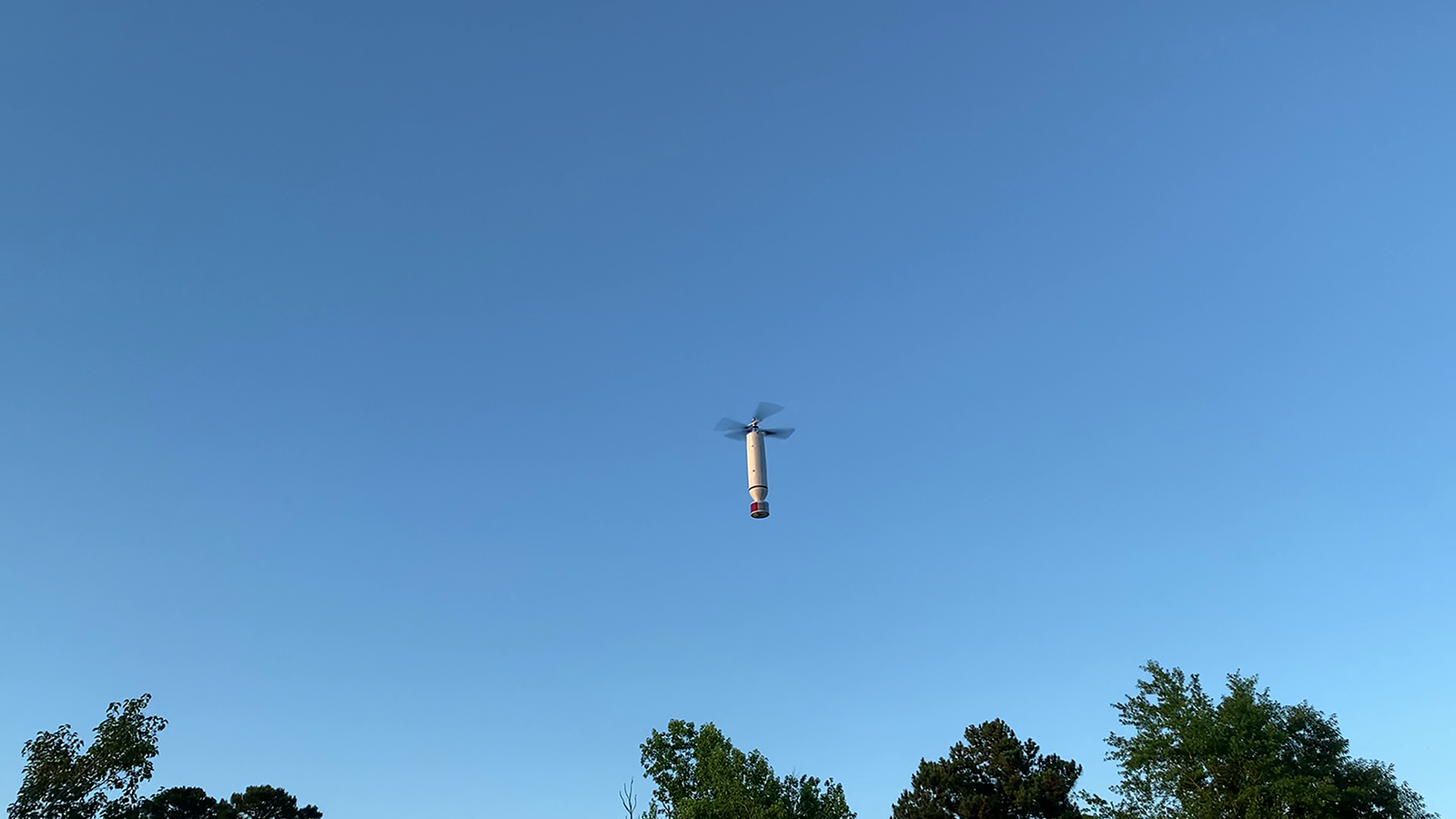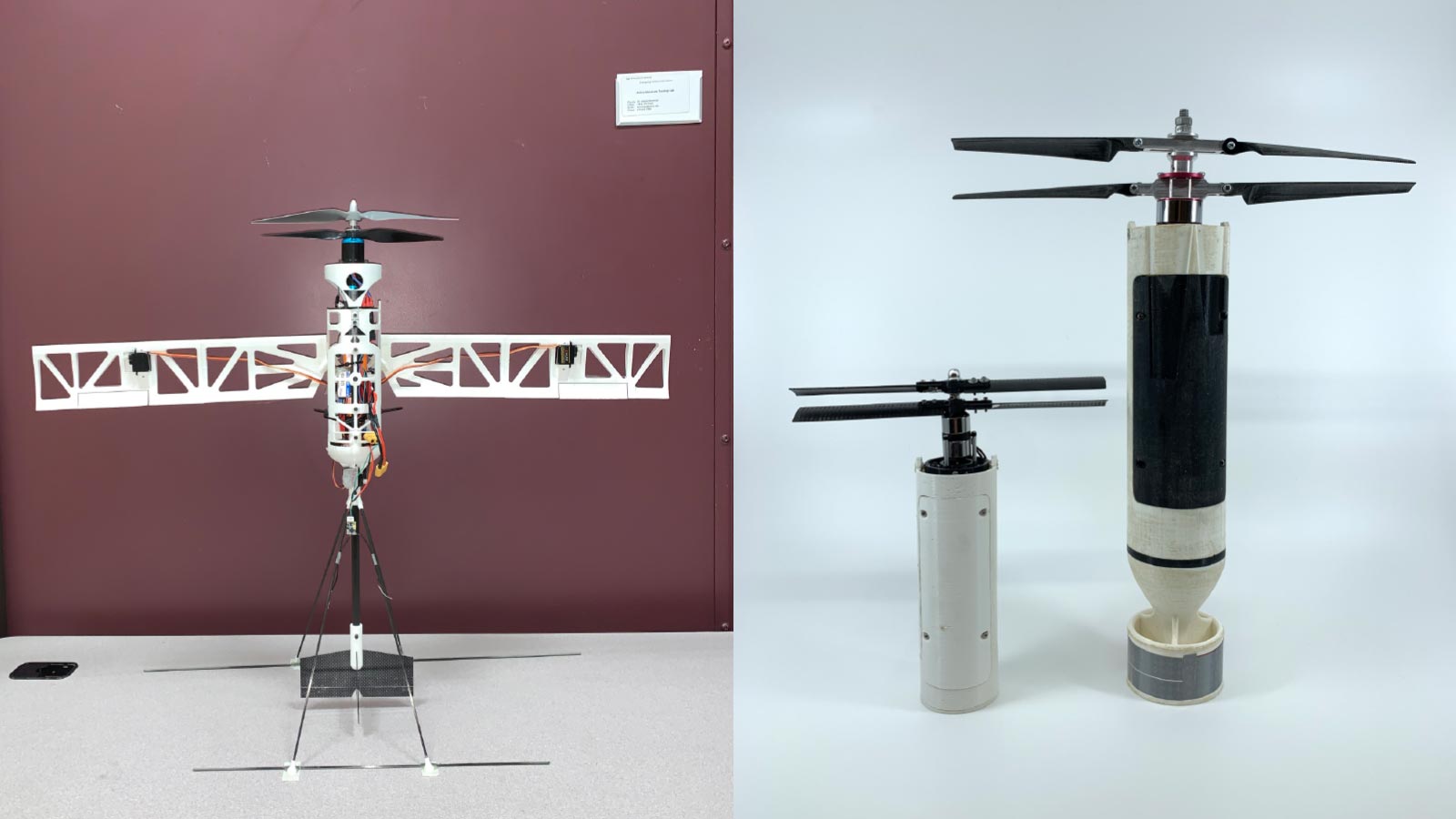Grenade-launched drones
By Keith Button|May 2024
U.S. researchers want to figure out how to make rotorcraft drones that can be folded up and launched from the standard-issue grenade launchers carried by many U.S. and allied troops. Keith Button has the story.
On a summer afternoon in Texas, on a field dotted with trees and cattle grazing in the distance, a white plastic pipe jutted about 2 meters into the air while a Texas A&M University Ph.D. student gave the countdown.
“Three. Two. One. Go!” A muffled pop echoed from the pipe as a sudden burst of compressed air hurled a large-thermos-sized projectile 30 meters into the clear blue sky. Seconds later, two counter- rotating rotors spinning on the same axis unfolded from the top of the cylinder with a whine, while flight control software aboard the drone struggled to control it as it slowly tumbled twice. Then the drone stabilized, hovered upright, traversed the sky and descended below the treetops, where the Ph.D. student — Hunter Denton, who was remotely piloting the drone — walked forward and plucked it from its hover with one hand.
This flight test was part of an effort by Texas A&M professor Moble Benedict and aerospace engineering students to develop a new category of rotary-wing drones that U.S. or allied troops could one day shoot from standard grenade launchers. Other possibilities include launching larger versions of the drones from tubes attached to crewed aircraft or speeding trucks. The drones could carry explosives or cameras into battle or serve as decoys to confuse enemy radar trying to target other aircraft.
U.S. and allied troops, as well as Ukrainian soldiers, already have access to small fixed-wing drones launched from tubes, namely the AeroVironment-made Switchblades, whose wings unfold like a knife when launched. While rotary-wing drones in general offer the advantages over fixed-wing designs of being able to hover and fly more precise flight paths, on the battlefield they’re limited by their relatively short ranges: They can use up much of their battery just flying to the target. But such a drone propelled to its target by grenade launcher, a weapon that typically resembles an oversized revolver with fist-sized bullets, could save its energy for loitering and maneuvering near its target. Plus, by being propelled by a mortar-like explosive force and then unfurling, a drone is at a reduced risk of being exposed to enemy defenses by the whine of its rotors over a long flight path.
The eventual goal of the Texas A&M researchers is to produce an autonomous drone that an infantry soldier could send to its target or mission without needing to remotely pilot it or to carry a specialized launcher, Benedict says. “We want to use common infantry equipment. We don’t want to have anything specialized for this.”
Similarly, a tube-launched drone could be carried into battle by larger vehicles, saving its battery until the moment it is needed, then be launched in an instant.
When Benedict’s team started this research in 2019 — working under a $385,000 grant from the U.S. Army Research Laboratory — the initial challenge was coming up with a drone that could be packed into the 40-millimeter-wide barrel of a standard grenade launcher, about the width of an eyeglass lens. They decided on a coaxial design of two counter-rotating rotors stacked on the same axis, because the drone could be folded up more easily than a miniaturized quadcopter, for instance, and its motors and servos could be packed in a cylinder.
This coaxial configuration comes with other benefits. The two rotors, unfolding to fill a single disk footprint like that of a salad plate, provide more thrust than the four rotors of a quadcopter with the same total disk area, permitting the aircraft to fly farther on the same charge. It’s also quieter, with two large rotors instead of four small rotors spinning faster.
Then there was the challenge of how to control pitch and roll for the drone. A conventional helicopter controls those movements with a swashplate attached to each rotor with a rod to control the pitch of individual rotors — a configuration that would be far too difficult to pack into a tube and then unfurl to fly the drone. Instead, the decision was made to control the aircraft by tilting the entire rotor disk.
They decided to ease the engineering challenge further by starting with a slightly larger tube size of 52 mm, with the intent of scaling down the design in future iterations. To keep costs manageable, they chose to eject each drone with compressed air at 70 pounds per square inch, rather than explosive rounds. This way, they wouldn’t have to harden the drone’s electronics and other components against an explosive force, Benedict says.
They knew that aerodynamic efficiency drops for the rotors of tiny drones compared to the rotors of larger drones, so they needed to find the airfoil shape and width for the rotors that would provide the best lift-to-drag ratio and the most efficient thrust. They tested various virtual blades in computer models, but measuring the small lift and drag forces imparted on various shapes of tiny physical blades cutting through air at their true rotational speed would have been too great of a challenge. So for their physical tests, they decided to create the same lift-to-drag ratios with water as the medium instead of air, and with scaled-up 60-centimeter-long blades machined from aluminum instead of the actual tiny-drone-sized carbon fiber blades. To test a particular blade shape, they inserted it vertically into a lab “water tunnel,” a channel of water 6 to 9 meters long and about 60 cm wide, and increased the flow to match the aerodynamic forces of its analog: a smaller blade spinning through air, which is 800 times less dense than water. Then they measured the lift — how much the water pushed the blade to one side of the trough — and drag — how much the blade was pushed downstream — with force sensors attached to the end of the blade sticking out of the water.
They also spun actual-size rotors on a small electric motor that was attached to force sensors that measured thrust and torque. The upper and lower rotors in a coaxial configuration generate different levels of thrust, because the lower rotor is operating in the wake of the upper. So to measure their combined thrust, the lower rotor’s motor and force sensors were mounted on the end of a vertical stick and the upper rotor, motor and force sensors were on a stick hanging from the ceiling — a mirror setup.
Based on their modeling and water tunnel tests, they chose a curved blade with a very sharp leading edge — more akin to the wings of insects than the wings of airplanes, Benedict says. They also figured out the ideal spacing between the rotors and the ideal rotor pitch angles to maximize thrust and torque and minimize noise.
So far, the team has demonstrated a vertical launch from the 52-mm tube, with the drone deploying at the highest point of flight from the initial blast of air. Before the grenade launcher research wraps up next May, they want to test a ballistic launch from an angled tube, with a projectile unfolding into a drone on its downward flight path and then flying autonomously to a GPS-located target, Benedict says.
That downward projectile flight will require a different design for the drone, with both the rotors and four stabilizing fins attached to the trailing end of the cylinder, which will be pointing up as the projectile descends. For the vertically launched drone design, the rotors were on the front and the fins were on the tail to stabilize the cylinder during its projectile flight.
One concept the team is testing for the fins is to attach them via a threaded hub that unscrews and releases the fins as the rotors spin up to transition from projectile to drone flight. The rotors would then slow down the cylinder on its downward flight path as it turned into a hovering drone.
The slowing-down part of the flight for angled launch — when the rotors act like a parachute to brake the descent of the cylinder — introduced another challenge, Benedict says. When they tested the descent phase, they discovered that the drone went into a “vortex ring state,” a “crazy oscillation” that it couldn’t recover from, he says. This is what can happen to a helicopter that descends at a certain speed through its own downwash.
“If you descend very slowly, it’s fine. If you descend at a very fast rate, you’re fine. But there is this intermediate rate of descent where you can enter into this instability,” Benedict says.
To test for the descent phase, they flew the drone over fields and parks in and around Texas A&M’s College Station campus. At heights of 60 to 90 meters, they reduced the thrust so the drone would accelerate toward the ground. Then at about 30 meters, they boosted the thrust again to see how the drone responded and if an oscillation occurred, and repeated the test.
Their strategy for cushioning the inevitable crashes? “We look for fields where the grass is really tall,” Benedict says.
Over a few months, the drone crashed 10 to 20 times during testing for the oscillation problem. Then the team decided to set up the oscillations in a wind tunnel, with the drone mounted on a hinge horizontally to mimic the airflow from a descent. By repeating the oscillation conditions over and over, they were able to tune the flight control software to manage the descent phase without losing control, Benedict says.
While testing is ongoing, the grenade-launched design has already sparked another idea. Under a separate project, the researchers are also developing drones that could be launched from a 25-mm Common Launch Tube, a standard tube for carrying munitions and missiles on helicopters and fixed-wing aircraft. That research, under a five-year $750,000 grant from a joint Army, Navy and NASA Vertical Lift Research Center of Excellence program, has so far produced a coaxial-rotor drone that would also unfurl from a canister shape, similar to the grenade-launched concept. But unlike the grenade-launched drone, the tube-launched version can fly as either a fixed-wing or rotary-wing aircraft. With the tube-launched design, the fixed wings fold flat against the cylinder shape of the drone by rotating like a bird’s shoulder joint.
Key to this research will be developing a database of the aerodynamics and basic physics for various drone concepts, including how they react to the wake generated from the helicopters or planes they are launched from, says Mahendra Bhagwat, who heads basic research for the U.S. Army’s Vertical Lift Research Center of Excellence at Moffett Field, California.
“Even during that short timespan when it unfolds and before it can start flying, that’s really crucial because it can fly smoothly or it can really go unstable, all within just a few seconds,” he says.
It’s also important to generate data that future designers can base their own drones on, not just build flying prototypes, Bhagwat says. “Oftentimes, innovation outpaces our understanding of how it works,” he says. A researcher can build a drone that flies as intended 100% of the time, “but then we need to take a step back and figure it out; we have to understand which things work and why.”











